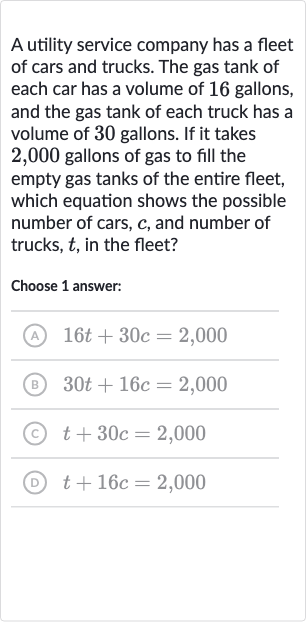AI tutor
Welcome to Bytelearn!
Let’s check out your problem:

A utility service company has a fleet of cars and trucks. The gas tank of each car has a volume of gallons, and the gas tank of each truck has a volume of gallons. If it takes , gallons of gas to fill the empty gas tanks of the entire fleet, which equation shows the possible number of cars, , and number of trucks, , in the fleet?Choose answer:(A) (B) (C) (D)
Full solution
Q. A utility service company has a fleet of cars and trucks. The gas tank of each car has a volume of gallons, and the gas tank of each truck has a volume of gallons. If it takes , gallons of gas to fill the empty gas tanks of the entire fleet, which equation shows the possible number of cars, , and number of trucks, , in the fleet?Choose answer:(A) (B) (C) (D)
- Define variables: Define the variables for the number of cars and trucks.Let represent the number of cars and represent the number of trucks.
- Write equation based on gas tank volume: Write an equation based on the volume of gas tanks for cars and trucks.Each car has a gas tank of gallons, and each truck has a gas tank of gallons. The total volume of gas needed to fill all the tanks is gallons.The equation will be of the form:
- Translate information into mathematical equation: Translate the information into a mathematical equation.
- Match equation with given options: Match the equation with the given options.The equation we derived is , which matches option (B).
